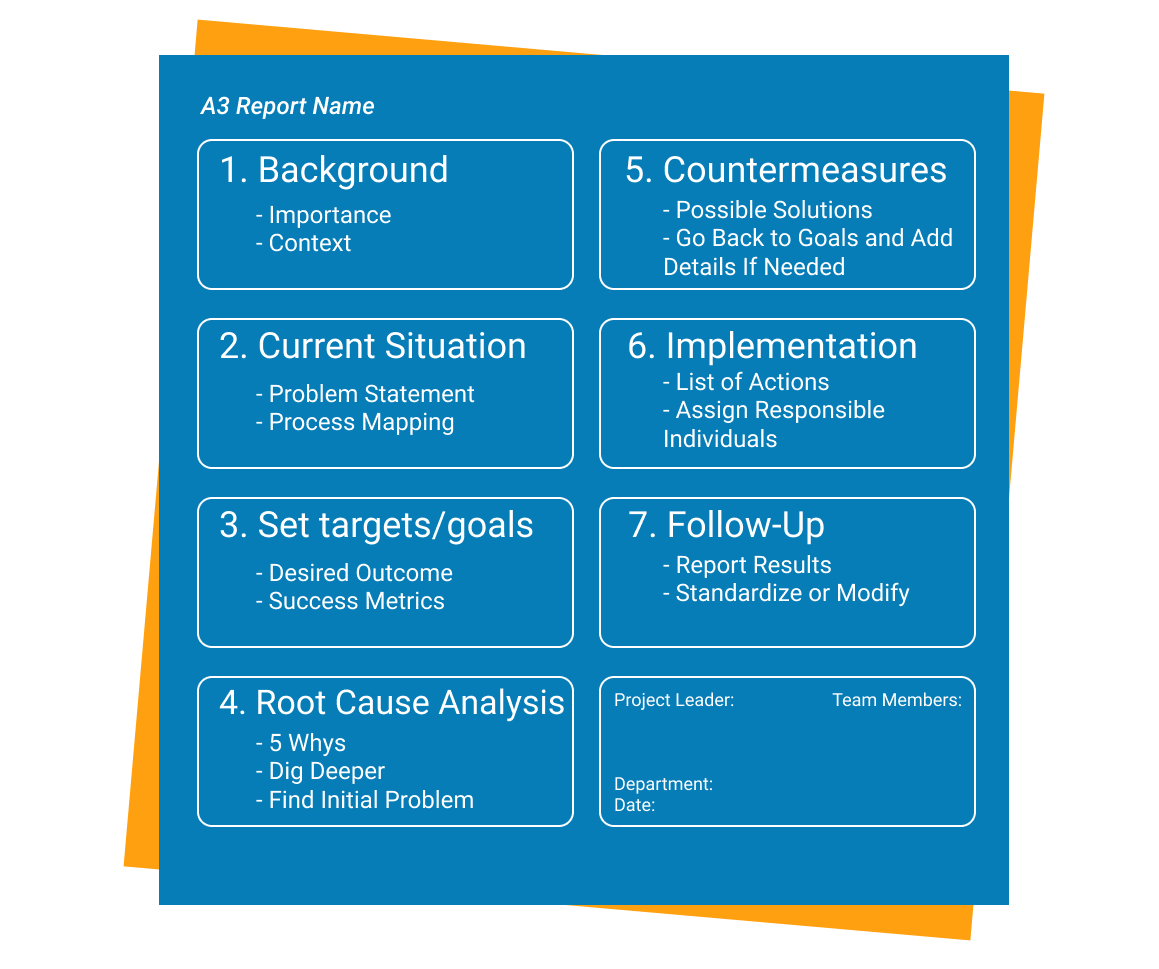Key Takeaways
-
What is A3? A one-page Lean report used to solve problems by aligning people and processes through structured thinking.
-
Why is A3 important in Lean? It reinforces root cause thinking, encourages collaboration, and supports continuous improvement.
-
What are the key parts of an A3 report? Background, Current Situation, Targets, Root Cause Analysis, Countermeasures, Implementation Plan, and Follow-up.
-
Who's involved? Typically, an owner, mentor/coach, and cross-functional responders.
What Is A3 Problem-Solving?
A3 problem-solving is a structured approach rooted in Lean thinking that helps teams solve problems at the source - permanently. Instead of just fixing symptoms, A3 focuses on identifying and addressing root causes so problems don't keep coming back. The A3 method is named after the A3-sized sheet (11" x 17") used to document the entire process, making communication clear and actionable across teams.
Where Did A3 Come From?
A3 reporting originated from the Toyota Production System. Although there's no single inventor, Isao Kato and others evolved it as a blend of the PDCA (Plan-Do-Check-Act) cycle and Toyota's emphasis on visual communication. Legend has it that Taiichi Ohno, one of Toyota's key figures, refused to read reports longer than one page, which led to the A3 format we know today.
What Is A3 Thinking in Lean?
A3 thinking is more than filling in a form - it's a mindset built on logic, transparency, and collaboration. Seven principles define it:
- Logical step-based thinking
- Objective presentation of facts
- Linking results to processes
- Visualizing key information
- Aligning efforts with organizational goals
- Promoting shared perspectives
- Structuring problems for effective resolution
This way of thinking encourages everyone involved to slow down, reflect deeply, and collaborate across departments.
Who Is Involved in an A3 Report?
The A3 model is not a quick fix - it's a structured problem-solving process that requires commitment and open communication from all parties involved. There are three key roles:
-
Owner: Manages the A3 process and maintains the report.
-
Mentor/Coach: Guides the owner without giving direct solutions, encouraging learning and critical thinking.
-
Responders/Stakeholders: Individuals impacted by the problem and its solution; their input is vital.
Access to stakeholders, especially in rigid hierarchies, can be challenging. That’s why lean thinking must be embraced organization-wide to ensure cooperation. Ultimately, strong communication among all roles is essential for A3 success.
How to Use A3 Problem-Solving: Step-by-Step
An A3 report documents the entire problem-solving process on a single page, typically following seven core steps. Each step builds on the last, guiding teams from identifying the problem to verifying whether the solution worked and sharing results.
1. Form a Cross-Functional Team
Involve people who are familiar with the process. Having multiple perspectives improves insights and solution quality.
2. Define the Problem
Be concise. Define the scope clearly so you don't waste time or end up with an unmanageable scope.
3. Start Asking "Why"
Use the 5 Whys technique to dig deeper into the problem. Be honest and data-driven - not emotional. Stop when the real root cause is clear.
Tip: If the answers branch into multiple directions, you might uncover more than one root cause - which is okay!
4. Take Corrective Action
Once you know the root cause, brainstorm and document countermeasures. Make sure the team agrees on the best path forward.
5. Implement the Plan
Assign responsibilities, define timelines, and ensure accountability. This helps turn ideas into measurable outcomes.
6. Confirm and Follow Up
Check back in. Did your countermeasures work? If not, refine and repeat. If yes, standardize your improvement and share the results.
7. Document Everything
Record the entire journey on your A3. Share it with others to promote organizational learning and prevent future issues.
 Visualization of an A3 report example and its building components
Visualization of an A3 report example and its building components
Best Practices for A3 Problem-Solving
Use a coach or mentor to guide the process without giving direct answers.
- Encourage team participation - A3 is collaborative by design.
- Visualize your findings where possible. Diagrams and charts help.
- Focus on facts, not assumptions. Use real data.
- Align solutions with your company's strategic goals.
A3 Problem-Solving Template
| Step |
Purpose |
| Background |
Explain why the issue is important |
| Current Situation |
Map and describe the existing conditions |
| Set Targets |
Define what success will look like |
| Root Cause Analysis |
Uncover the real cause using tools like 5 Whys |
| Countermeasures |
Brainstorm solutions to address the root cause |
| Implementation Plan |
Assign actions, responsibilities, and deadlines |
| Effect Confirmation |
Measure outcomes, adjust if necessary, and share across the org |
When to Use the A3 Tool
Use A3 problem-solving for:
- Recurring issues that need root cause analysis
- Process inefficiencies or bottlenecks
- Cross-departmental problems where collaboration is key
-
Continuous improvement projects aligned with Lean or Six Sigma
- The A3 tool works well alongside other methods like the 5 Whys, Fishbone Diagram, and DMAIC from Six Sigma.
Tools that Support A3 Problem-Solving
Look for platforms offering digital A3 templates, collaborative editing, version tracking, and visual process maps - all of which make A3 implementation smoother and more actionable across distributed teams. In Businessmap, you can generate an A3 report template using the AI-powered functions of the whiteboards, collaborate in real-time with your team, and implement findings directly into your usual workflow.
More than One-Page Report
A3 is more than just a one-page report - it's a culture shift toward thinking deeply, solving collaboratively, and acting with purpose. Whether you're dealing with manufacturing issues, workflow delays, or cross-functional misalignment, the A3 approach can bring clarity, structure, and long-term results.
Businessmap is the most flexible software
to align work with company goals





 Visualization of an A3 report example and its building components
Visualization of an A3 report example and its building components


